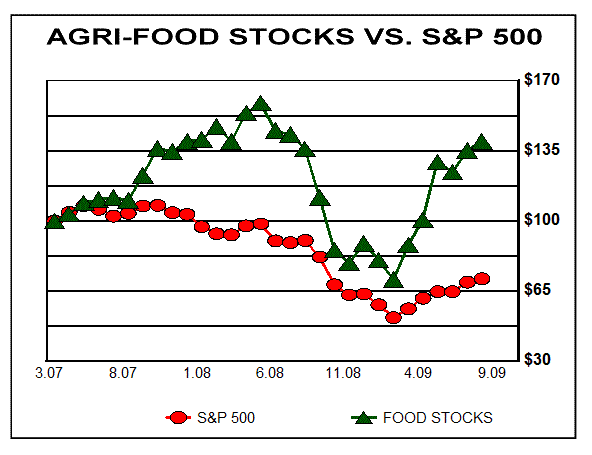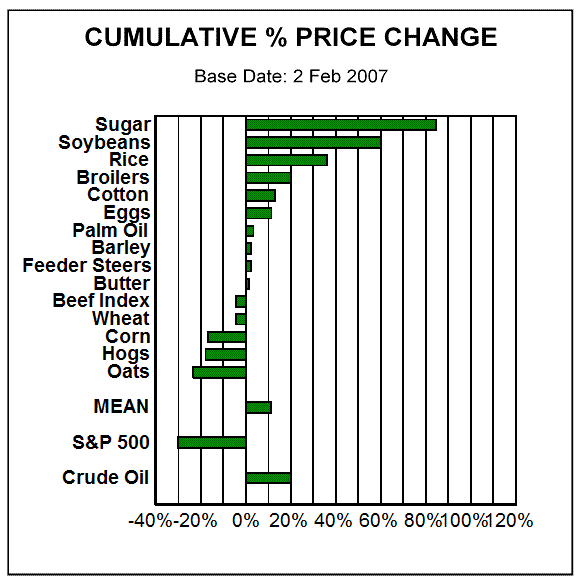Food Crisis and This Years Indian Rice Crop Failure Impacts on Agri-Food Investments
Commodities / Agricultural Commodities Aug 10, 2009 - 07:23 PM GMTBy: Ned_W_Schmidt
 Sometime people do learn from history, though the number that intentionally do so are few. Perhaps one of the largest groups of people that seem to lack the ability to learn from history is composed of economists. The facts that they choose to intentionally ignore are near mind boggling. Two asset bubbles, technology and housing, were claimed to be non existent, until they collapsed. Now, that same group of myopic number crunchers believes that economic growth in Western economies is about to reignite. Is some skepticism appropriate?
Sometime people do learn from history, though the number that intentionally do so are few. Perhaps one of the largest groups of people that seem to lack the ability to learn from history is composed of economists. The facts that they choose to intentionally ignore are near mind boggling. Two asset bubbles, technology and housing, were claimed to be non existent, until they collapsed. Now, that same group of myopic number crunchers believes that economic growth in Western economies is about to reignite. Is some skepticism appropriate?
Now again, in the aftermath of the Federal Reserve doubling its assets, we wonder if deja vu is not recurring. With Chairman Bernanke running for reappointment in January as Chairman, the Federal Reserved has launched Cash-For-Clunkers III, the monetization of the Obama Regime’s massive deficit. With the Obama Regime in failing and fading mode, can any good come out of all this monetization. Easy money twice created asset bubbles that burst, so the Federal Reserve will try it again. Little wonder Chinese government condemns U.S. economic policy, and ignores the advice given by U.S. economists.
The Chinese economy continues to grow, by almost 8% in the latest report. Perhaps we now know what Mao’s last words might have been, “Do not listen to Yankee economic dogs!” While the Obama Regime focuses on destroying wealth, the Chinese government continues to create it. Will that record of growth be uninterrupted? Of course the answer to that question is no. But China is about where the U.S. was in 1900. The good part is yet to come!
Investors have wisely sought to protect their wealth from the policies of governments such as the Obama Regime and Argentina, to name just two of the most dangerous. They have done so by buying and owning Gold. Policies now being pursued in Washington, D.C. have a lot in commmon with the wealth confiscation policies of Argentina. That nation has done so twice in recent history, once by seizing bank deposits and once by nationalization of private pensions. Gold may become the only defense against continuing wealth confiscation by governments. By the way, worry little about your Gold being confiscated. They are too busy going after everything else you own.
But, as we have said before, investors need an offensive component to their portfolio. We cannot participate directly in the wealth creating activities of China. We can, however, invest in those companies and assets that will benefit from that wealth creation. One of those major beneficiaries of China’s wealth creation is Agri-Food. As people get wealthier, they eat better.
The World Soybean Research Conference VIII is being held this week in Beijing, China. Can that be happening just by chance? Can that be happening cause Beijing is known as a great resort city? Or, can it be happening be happening cause China is world’s biggest importer and consumer of soybeans? China has learned how to solve the problem of hunger, and food is not the answer. Income is the answer! They will simply buy the soybeans and whatever other Agri-Foods needed.
As our first chart below portrays, those involved in Agri-Food investing have been doing very well. Does that mean those running these companies are brilliant? No. And no, they are not creating social networking web sites, or other such drivel. Nor do they prosper from the clicking of web-based advertisements. But yes, they do serve the Agri-Food chain serving BRICA, Brazil, Russia, India, China, and ASEAN. Global consumption of Agri-Food is a continuous, ongoing process not subject to fads. It is a necessity.

That Agri-Food investments continue to do well is not due to chance. The fundamentals behind these companies remain in good standing, despite the global economic recession. The chart below portrays the performance of Agri-Food prices over the last few years. Those prices have risen as global demand has risen while supply has difficulty expanding. Global grain production will fall this year from the aberration of last year’s production. That level of production, due to a rare combination of money, weather, and optimism, may not be exceeded in the foreseeable future.
While the trading pits of North America are in euphoric states over this year’s possible harvest, in India conditions are not so good. One would have to judge this year’s monsoons as a failure. Per bloomberg.com(10 Aug 2009), India had the driest June in more than 80 years. A significant part of this season’s intended Indian agricultural planting will not take place. That situation is already putting significant pressure on sugar prices, as we have talked before.

What is not being adequately discussed is the loss of rice production in India due to the failure of the monsoons. India, with more than 1.1 billion people, has a near dysfunctional system of providing water to agriculture. That ramifications of this dire situation are made more apparent when the monsoons fail. A significant portion of the Indian Agri-Food harvest will be lost this year due to the water situation. And note, rice and sugar are not produced in factories, but must be grown in a field. Once part of a crop is lost, it is permanently lost. Not till a year later will a new crop be available, unlike the production of a factory.
India will likely be forced to enter world grain markets to make up the shortfall in domestic production. Unfortunately, the global grain bins cannot supply unlimited amounts of grain at today’s prices. An important bottom, therefore, is being put in place in global grain prices.
Many do not understand that the global Agri-Food network is much like a Rubik’s Cube. A change of one block influences all sides of the cube. The same is true with global Agri-Foods. Any loss of rice production in India has an impact on the wheat market in North America. The current state of near euphoria in North America on the outlook for this year’s harvest may be premature, and ignoring the Rubik’s Cube nature of Agri-Food.
If your wealth is now being protected by Gold, your investment decisions have been wise. Coming collapse of the U.S. dollar will make that Gold more valuable. The same currency effect will make North American Agri-Food production more valuable, as it is generally priced in dollars. Now that you own Gold, moving some of your remaining wealth into an offensive mode with Agri-Food should be considered. Read more at http://home.att.net/~nwschmidt/Order_AgriValueRECENT.html
By Ned W Schmidt CFA, CEBS
AGRI-FOOD THOUGHTS is from Ned W. Schmidt,CFA,CEBS, publisher of The Agri-Food Value View , a monthly exploration of the Agri-Food grand cycle being created by China, India, and Eco-energy. To receive the most recent issue of this publication, use this link: http://home.att.net/~nwschmidt/Order_AgriValueRECENT.html
Copyright © 2009 Ned W. Schmidt - All Rights Reserved
Ned W Schmidt Archive |
© 2005-2022 http://www.MarketOracle.co.uk - The Market Oracle is a FREE Daily Financial Markets Analysis & Forecasting online publication.



